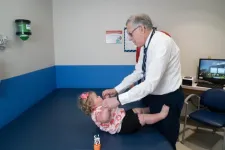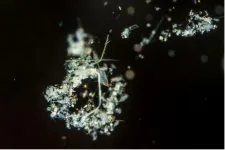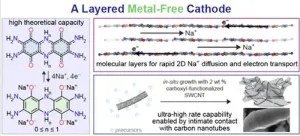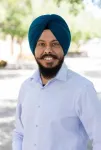(Press-News.org)
(MEMPHIS, Tenn. – February 19, 2025) Spinal muscular atrophy (SMA) is a progressive neurodegenerative disorder set in motion before birth. Scientists at St. Jude Children’s Research Hospital led the first in uterotreatment of SMA with the orally administered drug risdiplam. More than two years after the child was born, no identifiable features of SMA have been observed. This study demonstrates the feasibility of treating SMA prenatally and supports further investigation into the approach. The findings were published today in a letter to the New England Journal of Medicine.
“Our primary objectives were feasibility, safety and tolerability, so we’re very pleased to see that the parent and child are doing well,” said the study’s corresponding author Richard Finkel, MD, St. Jude Center for Experimental Neurotherapeutics director and Department of Pediatric Medicine member. “The results suggest it would be worthwhile to continue investigating the use of prenatal intervention for SMA.”
SMA is caused by a lack of survival motor neuron protein and occurs in around 1 in every 11,000 births in the United States. If not treated, SMA type 1 (SMA-1), the most common and severe form, results in progressive muscle weakness that leads to death. Currently, treatments for SMA-1 have demonstrated improved survival and motor function in infants, especially if administered shortly after birth before symptoms begin, but is not a cure.
N-of-1: A case study of prenatal risdiplam
Survival motor neuron protein is most needed in the third trimester of fetal development and the first three months of life after birth. Symptom severity is, therefore, closely linked with the intervention time point. Due to this clinical need, the St. Jude researchers, as part of the Pediatric Translational Neuroscience Initiative, launched a unique clinical protocol to study risdiplam in a single patient. The goal was to determine the feasibility of starting treatment for a fetus with SMA-1 in utero.
The parents in this case were both known carriers of SMA genetic variants and had a prior infant born with SMA-1 before current treatments became available, who died at 16 months of age. Genetic testing conducted by amniocentesis confirmed the fetus had no copies of the survival motor neuron gene, which, in combination with the family history and other genetic information, was highly predictive of the infant being born with SMA-1. Risdiplam was administered to the expectant mother during the final six weeks of pregnancy.
Safe and promising outcome encourages future research
Shortly after birth, the infant was diagnosed with three developmental abnormalities: ventricular septal defect (which resolved), optic nerve hypoplasia and a brainstem asymmetry, with related delays in vision and overall development. These abnormalities are considered to have occurred early in fetal development before exposure to risdiplam.
Now two-and-a-half years old, the child continues to be monitored periodically at St. Jude. “During the course of the assessment, we really have seen no indication of any signs of SMA,” Finkel said. The research demonstrates the safety and feasibility of the approach and bolsters the case for a more comprehensive study.
Authors and funding
The study’s other authors are JulieAnn Parker of OBGYN Partners of Augusta; Lutz Mueller and Heidemarie Kletzl of F. Hoffmann-La Roche Ltd.; and Samuel Hughes, Matthew Civitello, Alfonso Lavado and Heather Mefford of St. Jude.
The drug used in this study was provided by F. Hoffmann-La Roche, and the study was supported by funding from the American Lebanese Syrian Associated Charities (ALSAC), the fundraising and awareness organization of St. Jude.
St. Jude Media Relations Contacts
Chelsea Bryant
Desk: (901) 595-0564
Cell: (256) 244-2048
chelsea.bryant@stjude.org
media@stjude.org
Rae Lyn Hartley
Desk: (901) 595-4419
Cell: (901) 686-2597
raelyn.rushing@stjude.org
media@stjude.org
St. Jude Children’s Research Hospital
St. Jude Children’s Research Hospital is leading the way the world understands, treats and cures childhood cancer, sickle cell disease and other life-threatening disorders. It is the only National Cancer Institute-designated Comprehensive Cancer Center devoted solely to children. Treatments developed at St. Jude have helped push the overall childhood cancer survival rate from 20% to 80% since the hospital opened more than 60 years ago. St. Jude shares the breakthroughs it makes to help doctors and researchers at local hospitals and cancer centers around the world improve the quality of treatment and care for even more children. To learn more, visit stjude.org, read Progress: A Digital Magazine and follow St. Jude on social media at @stjuderesearch.
END
How on Earth?
It has puzzled scientists for years whether and how bacteria, that live from dissolved organic matter in marine waters, can carry out N2 fixation. It was assumed that the high levels of oxygen combined with the low amount of dissolved organic matter in the marine water column would prevent the anaerobic and energy consuming N2 fixation.
Already in the 1980s it was suggested that aggregates, so-called “marine snow particles”, could possibly be suitable sites for N2fixation, ...
The U.S. Food and Drug Administration (FDA) has approved vimseltinib (RomvimzaTM) for adult patients with a rare condition called tenosynovial giant cell tumor (TGCT). TGCT is a tumor of the tissue that lines the joints.
Sarcoma oncologist William Tap, MD, Chief of the Sarcoma Medical Oncology Service at Memorial Sloan Kettering Cancer Center (MSK), led the international phase 3 MOTION trial that resulted in the drug’s approval. Vimseltinib is a type of targeted therapy called a kinase inhibitor and is taken as a pill.
“This approval is an exciting advance for ...
The Columbia Climate School has announced the first master’s degree program in the United States for climate finance. In close collaboration with the Columbia Business School, this interdisciplinary degree will drive impactful solutions to the climate crisis through advanced financial tools and scientific knowledge. This is the third master’s program announced by the Climate School, in addition to an M.A. in Climate and Society and an M.S. in Climate degree.
“The world needs problem-solvers to address the global climate crisis,” said Alexis Abramson, dean of the Columbia Climate School. “Everyone ...
HOUSTON ― The University of Texas MD Anderson Cancer Center today was awarded nearly $23 million from the Cancer Prevention and Research Institute of Texas (CPRIT) in support of 20 cancer research projects to advance new breakthroughs in discovery, translational, clinical and prevention science. In addition, CPRIT awarded $2 million for the recruitment of one first-time, tenure-track faculty member.
“We sincerely appreciate CPRIT’s continued funding of impactful cancer research that will help us achieve our mission to end cancer,” said ...
Electrons oscillate around the nucleus of an atom on extremely short timescales, typically completing a cycle in just a few hundred attoseconds (one attosecond is a quintillionth of a second). Because of their ultrafast motions, directly observing electron behavior in molecules has been challenging. Now researchers from UC San Diego’s Department of Chemistry and Biochemistry have suggested a new method to make visualizing electron motion a reality.
This new method describes an experimental concept called ultrafast vortex electron diffraction, which allows ...
New London, Conn. — A new study by Connecticut College provides strong evidence that palm trees once thrived in subarctic Canada, reshaping scientific understanding of past Arctic climates.
Conn Professor Peter Siver’s research, published in the journal Annals of Botany, confirms that during the late early Eocene—approximately 48 million years ago—this region maintained warm temperatures year-round, even during months of winter darkness. The work was done in collaboration with colleagues from Canada and Poland.
Siver’s team identified fossilized phytoliths—microscopic ...
MINNEAPOLIS — Smoking, particularly heavy smoking, is linked to some unexplained strokes in younger adults, mainly in male individuals and in people ages 45 to 49, according to a study published in the February 19, 2025, online issue of Neurology® Open Access, an official journal of the American Academy of Neurology.
A stroke with no known cause, called a cryptogenic stroke, is a type of ischemic stroke caused by a blockage of blood flow, but it is unclear what has caused the blockage. Symptoms include weakness, trouble speaking and vision problems. Strokes can be fatal. Most strokes occur after age 65.
“While smoking has long been linked to ischemic stroke, ...
For decades, scientists have sought ways to counter our dependence on lithium-ion batteries. These traditional, rechargeable batteries energize today’s most ubiquitous consumer electronics – from laptops to cell phones to electric cars. But raw lithium is expensive and is often sourced through fragile geopolitical networks.
This month, Princeton University’s Dincă Group announces an exciting alternative that relies on an organic, high-energy cathode material to make sodium-ion batteries, advancing the likelihood that this technology will find commercialization with safe, cheaper, more sustainable components.
While scientists ...
DENVER - A new research study highlights the significant health risks associated with dust storms, revealing an increase in emergency department (ED) visits for respiratory and cardiovascular conditions, as well as motor vehicle accidents, in three Southwestern U.S. states. The study, which was led at National Jewish Health was published this month in JAMA Network Open.
Researchers at National Jewish Health, Emory University and the University of Colorado analyzed over 33,500 ED visits across Arizona, California and Utah from 2005 to 2018. The findings ...
LA JOLLA, CA—Current asthma treatments don't work in all patients, and they don't provide long-term relief from potentially deadly asthma attacks.
Scientists at La Jolla Institute for Immunology (LJI) are advancing a new kind of therapy. According to a recent study published in the Journal of Allergy and Clinical Immunology, their approach holds promise for providing long-lasting relief for people with asthma—and it may be useful for dampening immune inflammation in general.
The researchers have developed two therapeutic ...




